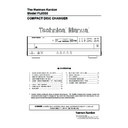Harman Kardon FL 8550 (serv.man13) Service Manual ▷ View online
FL8550
Signal to Noise Ratio
1. Set the mode of the filter to ‘ S/N’ mode
2. Play track 2 of the test disc
3. The unit of the audio analyzer is set to dB mode
4. Press the S/N key on the control panel of the audio analyzer
5. Play track 7
6. Measure the data of S/N ratio
Dynamic Range
1. Set the mode of the filter to ‘ D-Range’ mode
2. Set the audio analyzer to ‘ DIST’ Mode
3. Set the unit of the audio analyzer to ‘ dB’ mode
4. Play track 17of the test disc
5. The dynamic range should be |A| + 60dB
Channel Separation
1. Set the mode of the filter to ‘ DIST/CH-SP’ mode
2. Set the audio analyzer to ‘ LEVEL’ mode
3. Play the tracks 8, 9, 10 & 11
4. The measured results is the difference between L & R channel
De-emphasis
1. Press the ‘ THRU’ button of the CD filter
2. Play the track 2 of the test disc
3. Press the ‘ Relative Level’ and make it ‘ ON’
4. Select the track 12 and 13 and measure the L & R channels value
13
Circuit Description
1. RF AMP BLOCK
The KA9220 is designed for 3-spot type optical pick-up assembly. The photo detector is composed of 6
light sensor (A through F). The photo detector A, B, C and D detect audio modulation signal on the disc
and generate focus error signal.
RF I-V AMP (1) and RF I-V AMP (2) are converted current of PD1 (A + C) and PD2 (B + D) through the
58 Kohm Internal resistor into Voltage.
Furthermore, they are added to RF Summing amplifier.
This signal (A + B + C + D) is outputted from RFO (Pin66).
The output Voltage is as follow.
)
iPD2
iPD1
(
X
R3
V
RFO
+
−
=
)
R2
V
R1
V
(
X
R3
B
A
+
−
=
)
10K
V
10K
V
(
22K X
-
B
A
+
=
)
V
V
(
X
2.2
-
B
A
+
=
FL8550
14
2. TRACKING ERROR AMPLIFIER
The output of photo detector F is directed to the (-) Input of F I – V AMP and out of photo detector E is
directed to the (-) input of E I – V AMP.
These input signals are current.
E I – V AMP and F I – V AMP are converted into voltage from the current signal. When correct tracking,
two input (V
F
, V
E
) signals are equal. The occurrence of tracking error is due to difference between F I – V
AMP output and E I – V AMP output.
]
403K
X
I
273K
)
26K
13K
260K X
(
[
X
I
V
F
F
F
=
+
=
]
260K
R
260K
22K
R
R
[
X
I
V
A
B
A
E
E
+
+
+
+
=
accordingly,
1290K
X
)
I
-
I
(
V
F
E
1
TE
=
FL8550
15
3. FOCUS ERROR AMPLIFIER
The focus error amp is the difference between RF I – V AMP (1) output V
A
and RF I – V AMP (2) output
V
B
. This two (V
A
, V
B
) signals are each applied to the (-) and (+) input of focus error amp. As the result of
differential voltage, Focus error signal is appeared at FE1 Pin (Pin57). This FE1 Output Voltage (low
frequency) becomes (A + C) – (B + D), as follow V
FE1
= R1/R3 (V
B
– V
A
)
The focus error voltage is directed to the focus servo Block, to maintain optimum focusing at all times.
4. FOCUS OK GENERATION CIRCUIT
The focus OK circuit generates a timing window to monitor focus search status of focus servo. When
RFO (Pin 66) Voltage is more than –0.37V, the focus OK circuit is inverted. Time constant of HPF in EFM
comparator and in mirror circuit and that of LPF in focus OK circuit are determined bu capacitor (0.01
µ
F)
between RFI and RFO.
FL8550
16
Click on the first or last page to see other FL 8550 (serv.man13) service manuals if exist.

